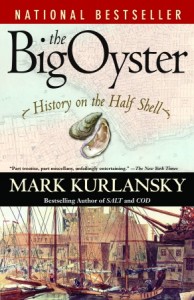
When I alphabetized by bookshelves to gain some order over the suburban sprawl of my TBR piles (read: four book shelves), I neglected to include any nonfiction in my overall reading strategy. I see now this was a mistake because I really love narrative nonfiction, especially when it’s well-written and about New York City. The Big Oyster: History on the Half Shell, while, yes, might be a bit repetitive and contain perhaps one too many historical recipes that feel like filler, fits the bill. I have never read anything else by Mark Kurlansky but I am ever-curious to read more of his nonfiction after finishing this book.
From the early Dutch settlers to the heyday of the Golden Age, New Yorkers have always consumed copious amounts of oysters. The social-anthropological thesis behind Kurlansky’s narrative fascinated me: human beings, in any situation, will simply ruin a natural, wonderful thing (oysters in the NY and surrounding harbours) by industry, profit and greed. And what’s worse, while the environmental message rings clear in this book, it’s amazing to me that even if they did bring the oysters back, the water at the bottom is so dead (no oxygen) that they wouldn’t survive. Ironically, as many activists point out, oysters are like vacuums cleaning up the waters for us. Annnywaay, that’s my rant about the ruination of our earth.
Back to the more fun things. It’s fascinating to examine the growth of a city through food — how it evolved, how it became an industry, and how said industry changed once the product disappeared for good. I loved how everyone in NYC: rich, poor, tourist, eats oysters — heck, my RRHB and I even took his parents to the beautiful oyster bar in Grand Central Station for dinner — all throughout history. Starting with the native peoples who first traded with the Dutch, through the English colonization and then downfall of their rule, and into the Golden Age, one thing remains constant: an unwaivering appetite for oysters among the inhabitants of one of the world’s greatest cities.
But Kurlansky’s broad spectrum also includes a lot of interesting historical facts, notes about famous people and their penchant for oysters, and great science about the bivalves themselves, and it’s all complete with a great narrative voice that speeds along. Like I said, it’s not perfect (there are too many recipes) but I just started skipping them towards the end. Because, honestly, am I ever going to eat an oyster? Not bloody likely. There’s no way I could get passed the fact that it’s alive and slimy when it slides down your throat. Ugh, I get shivers just thinking about it. But hell, I’m certainly happy I read about a whole bunch of other people who have eaten millions upon millions of them over the last 400 or so years.
I think the book grew out of an article that Kurlansky wrote for the NY Times. I couldn’t find it right at the moment but here’s the original Sunday book review.